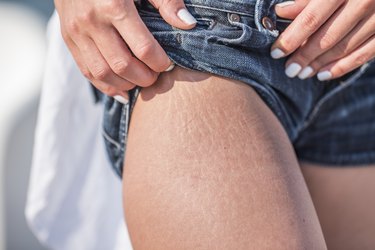
Just like a rubber band, your skin is designed to stretch and snap back — when the skin stretches too far, it breaks instead of snapping back. This results in scar tissue development known as stretch marks. These red-and purple-markings can be the unsightly reminder of weight gain and/or a growth spurt. Although typically harmless, you may experience some pain and itching with your stretch marks.
Significance
Video of the Day
Stretch marks typically are the result of changes to the skin that result in growth. Pregnancy, rapid weight gain or a growth spurt can stretch the skin excessively and cause stretch marks. Overuse of corticosteroid creams or pills also can contribute to stretch marks. These stretch marks can cause pain because the skin is being pulled. Just as if someone were pinching your skin, this can result in a sharp pain to the area. Itching also can be a side effect as the skin works to repair itself. Scar tissue that develops in place of healthy skin also tends to be harder than healthy skin. This can make your skin feel uncomfortable and can be painful when your clothing rubs against the stretch mark.
Video of the Day
Prevention
Prevent stretch marks through maintaining a healthy weight and keeping skin healthy. Drink plenty of water and keep the skin moisturized — this can help to minimize pain even when stretch marks do occur. Remember some people are predisposed to experience stretch marks; if your family members also experience stretch marks, you are at increased risk.
Treatment
Because stretch marks can constrict the skin, you may experience reduced blood flow to the area, resulting in pain. To remedy this, massage your scarred area, using a skin-softening lotion containing cocoa butter or vitamin E, recommends "The Doctors Book of Home Remedies." Avoid itching or picking at the stretch mark at all costs — even when the skin feels painful. Damage to the area can make the stretch marks worse and increase pain to the area. A cooling gel, such as aloe gel, can take some redness and inflammation away when applied to the stretch mark.
Expert Insight
Dr. Melvin L. Elson, a dermatologist and researcher, recommends using tretinoin cream as a stretch mark treatment, according to "The Doctors Book of Home Remedies II." However, you must use the treatment at a specific time. "The best time to use it [tretinoin cream] is when the stretch marks are new — when they are pink and a little painful," Dr. Elson said. "If you wait until the marks become white, the success rate plummets from 80 percent to around 10 percent."
Warning
If you experience stretch marks, yet have not experienced weight gain or hormone changes related, the University of Maryland Medical Center recommends you see your physician. On rare occasions, stretch marks can be the sign of a more serious condition, such as Cushing's syndrome, which indicates the adrenal glands are producing excess hormones.
Is this an emergency? If you are experiencing serious medical symptoms, please see the National Library of Medicine’s list of signs you need emergency medical attention or call 911.